AAC & CVI: Can We Chat?
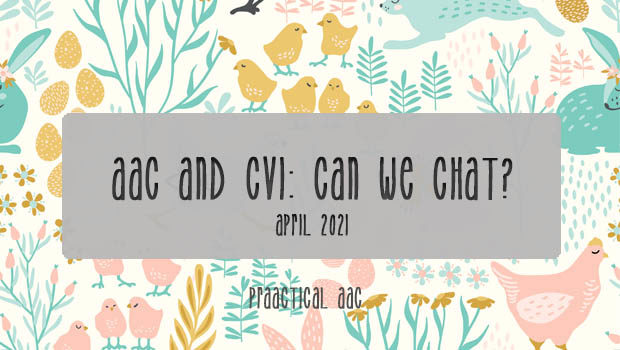

Dr. Sandra Newcomb
Do you serve students with cortical visual impairment (CVI)? Teacher of the visually impaired Dr. Sandra Newcomb and AAC SLP Debbie Perry regularly combine their expertise and collaborate to support children with CVI who are learning to use AAC.
In today’s post, they take us beyond the basics to share their thoughts on the complex issues that we should consider in serving this population. 
Follow along as they challenge some assumptions and provide helpful suggestions.
::::::::::::::::::::::::::::::::::::::::::::::::::::::::::::::::::::::::::::::::::::::::
AAC and CVI: Can We Chat?
Cortical Visual Impairment (CVI) is vision loss due to damage or malformation in the brain that interferes with the child’s ability to understand vision information coming from the eyes. It is the number one cause of vision impairment for young children in developed countries. It has been found that 10.5% of children with developmental disabilities have CVI [1]. This means if you are a pediatric SLP you will very likely find yourself working with children with CVI at some point in your career. Some of the top causes are CVI are hypoxic ischemic encephalopathy, periventricular leukomalacia, intraventricular hemorrhage, infection, trauma, and various genetic disorders which are also conditions common in children with multiple disabilities [2]. If any of the children you work with to provide alternative means of communication have these conditions in their medical history, you are likely working with a child who also has CVI.
In previous trainings, what SLPs have learned about working with children with CVI is that we need to present visual information in a specific way. You have likely learned that things should be visually simple, you should dim lights, and/or you should add movement to what the child sees. You may also have heard that these children are attracted to the colors red and yellow. This is all true, however, this is only part of the complex picture of designing AAC for a child with CVI. One of the most common misconceptions is that these children require symbols that are high contrast. This typically means bright-colored symbols on a black background. The critical piece of information that we need to remember about children with CVI is that the disability is about understanding what is seen. While bright colors may attract the student’s attention and specific colors may facilitate visual attention, none of that will help the child understand what they are viewing [4].
In addition to visual attention to symbols, we need the child to interpret or process what they are seeing. We can use preferred colors to increase visual attention, but we also need to be sure the child is able to interpret what they are seeing. This is a very important distinction between children with low vision (who are not able to see a small symbol) and children with CVI (who have typical acuity or clarity) but are not able to process or understand what they see. Children with CVI often look at what is in front of them, but their brains struggle to make sense of it.
High contrast symbols can actually increase visual complexity because they have multiple colors and many of them are the same color. The colors of these symbols are not the true colors of what the object is in real life. For example, a picture symbol of a horse that has the shape of a horse and is brown is close to the actual object it represents. A picture of a horse that is a yellow silhouette on a black background is very discrepant from the item it represents. This actually increases the confusion and complexity for visual processing and makes it more difficult for a student with CVI. So how can we, as SLPs use bright and preferred colors in AAC? We can use bright colors and preferred colors to help attract a child to find their communication device in a cluttered space and we also need to remember that those preferred colors may actually distract the child from finding their target. For instance, many times we have found a child to do really well with their SGD until we add in the stop sign or the apple for “eat” and all of a sudden that is the only cell they are attracted to.
Another thing to remember with the use of color is if we use a preferred color on the background of a cell to help the child attend to that cell then what happens is the child with CVI is looking at the color background and not the symbol. Then, if they see that symbol somewhere else without the color, they may be unable to interpret it. The moral of the story is that use of high contrast for children with CVI will increase their attention to something, but it will not help them interpret what they are seeing. It is very important that we use color strategically when working with children with CVI and focus more on decreasing complexity. Below are several examples of how high contrast has increased complexity:
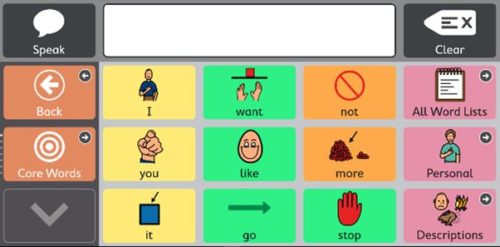
Visually Complex
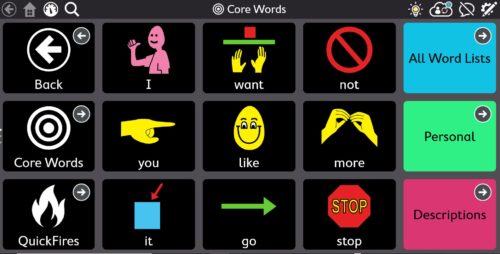
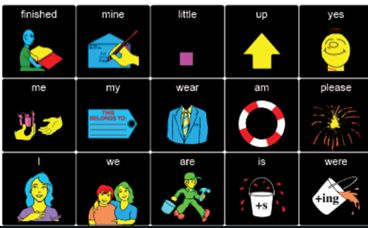
Equally, if not more, visually complex and the symbols have crazy colors that have nothing to do with real life.
These examples may attract a person with CVI’s visual attention, but they also may decrease it due to the complexity of the array in each.
So how can we simplify symbols? The one thing we have found for sure when working with children with CVI and complex communication needs is that there is not one fix for every child. You may need to try different things. Here are some suggestions:
- Try using symbols with 1-2 colors
- Make all symbol cells the same neutral color (black, white, etc.)
- Consider using the written word
- Make the color of the cells the same color as the background so you don’t add more complexity with the grid
We have been asked time and time again, “can’t we just teach these children to rely on motor planning?” The answer is motor planning is a huge component for all children using AAC and should definitely be taught to children with CVI, however, because these children still often look and can be taught to visually process what they are seeing, we should not expect them to only rely on motor planning. For instance, when you first began learning to use a keyboard you looked at the keys to figure out where things were and gradually began fading that to type without looking. A person who is blind or has low vision may rely solely on motor planning. A child with CVI has the capability to see and often will look and need to understand what they are seeing. As they become familiar with a device, they will use motor planning as an important tool. However, when they hit the wrong button, they use their vision to double-check the symbol. Often times a robust language system will be visually complex. We want them to use motor planning so that they do not use all their visual energy on using the device. Too much visual fatigue can lead to adverse behaviors or avoidance. So, in general, we do want children with CVI to use motor planning, but what is different from other types of visual impairment is that we want them to also visually recognize and understand the symbols. SLPs and other professionals need to systematically teach visual symbols to children with CVI.
Because of the unique visual characteristics of children with CVI, and the need for children to interpret what they are seeing, controversy over the representational hierarchy comes into play. When I first began my journey in working with children with CVI who also require AAC, I was appalled when my colleague and co-author of this post, Dr. Sandra Newcomb, insisted that there is a representational hierarchy we need to follow with children with CVI – objects, photos, symbols. This goes against everything we, as SLPs, are taught! As I learned more about CVI, I realized our reasoning must be different for these children. The typical approach is based on the fact that there is no research that shows that a child can cognitively understand a photograph any better than a symbol and the use of the representational hierarchy has actually been a myth that has kept people from using aided communication [3]. The difference with children with CVI is that we are asking the child to visually process what they are seeing across many domains. A large part of their overall educational program is to learn to make sense of the visual world. We want them to know that a photo of a dog is the same as a stuffed animal dog, real dog, red dog, brown dog, etc. For children with CVI they are not able to abstract the salient features of common concepts and generalize this visual information [4]. When they look at a random display of symbols, if they are not taught the 2-D representations, they are not making sense of any of it. Their responses are therefore inconsistent and at some point someone decides their failure with the device is due to cognitive delays when in fact they did not have visual access to the information in front of them.
So, are we saying that these children should have a more simplistic language system? Should we hold up their language until they progress through the phases of CVI? Absolutely not! Children with CVI need a robust language system just like everyone else and we cannot hold them back until they can process visual information better. They need core words to communicate, ability to communicate a variety of communicative functions, and access to a full language system just like any other person. So, you may think, “if people with CVI cannot visually process symbols how will we teach them core words and give them access to a robust language system?”. Well, you’re right, core words cannot be photographed or represented with objects and therefore, cannot be taught in a visual hierarchy. Objects and photographs can only represent nouns so how do we make sure children with CVI can have access to a robust language system including verbs, adjectives, etc and have the opportunity to express themselves just like we anyone else? We teach these symbols with a combination of motor planning and strategic design. Remember, simply adding high contrast to these symbols will not help these children understand core words but teaching symbols in the context of meaningful activities will help. If we use strategic placement and careful consideration of color and symbol details and if we use systematic teaching and opportunities for practice, children with CVI will learn these important symbols. That is a conversation for a future post.
References
[1] Nielsen, L. S., Skov, L., & Jensen, H. (2007). Visual dysfunctions and ocular disorders in children with developmental delay. I. prevalence, diagnoses and aetiology of visual impairment. Acta Ophthalmologica Scandinavica, 85(2), 149-156. doi:10.1111/j.1600-0420.2006.00867.x
[2] Cortical visual Impairment: Symptoms & Causes: Boston Children’s Hospital. (n.d.). Retrieved March 25, 2021, from https://www.childrenshospital.org/conditions-and-treatments/conditions/c/cortical-visual-impairment/symptoms-and-causes
[3] Romski, M. and Sevcik, R., 2005. Augmentative Communication and Early Intervention. Infants & Young Children, 18(3), pp.174-185.
[4] Cortical Visual Impairment: An Approach to Assessment and Intervention, 2nd ed. (2018). Roman-Lantzy, C., Louisville, KY: APH.
About the Guest Authors
Debbie Perry, MSR, CCC-SLP, ATP: Debbie Perry has worked as an SLP for over 15 years and has been specializing in working with children using AAC for 10 years. She has extensive experience working with children with complex communication needs and multiple disabilities. Approximately 7 years ago she began working with and learning more about CVI as she realized she could not fully help the children she worked with without that knowledge. She has been lucky enough to work with Dr. Sandra Newcomb to learn more about how to help these children better access communication. Debbie currently owns and operates private practice providing in-home therapy in the northern Virginia area. She has not financial or non-financial relationships related to this topic
Sandra Newcomb, Ph.D.: Sandra is a certified/licensed teacher of the visually impaired with more than 30 years of experience. She is in private practice and most of the children she serves have a diagnosis of CVI. Of those, many use AAC. She has had no formal training in AAC but works with brilliant AAC practitioners such as Debbie Perry and enjoys collaborating with SLPs to meet the communication needs of her students with CVI. Sandra conducted a study to determine the reliability of The CVI Range and currently teaches a course to endorse professionals to administer the range. She has no financial or non-financial relationships related to this topic.
Filed under: Featured Posts, PrAACtical Thinking
Tagged With: CVI, low vision
This post was written by Carole Zangari
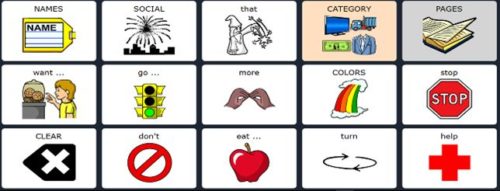


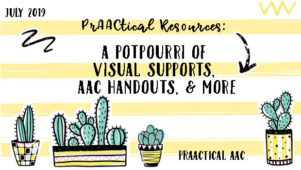
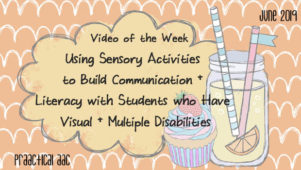
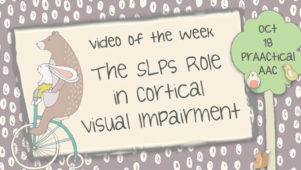
7 Comments
This is some of the most useful and practical (PrAACtical!) information I have encountered on this topic. THANK YOU! Can’t wait for the next post!
Thank you so much Kara!
Thank you Debby! I SOOOO enjoyed the AAC-CVI course last summer and all of your info was extremely helpful in adjusting devices to better suit kids’ individual needs. Thanks for this great review of information.
Hi Mary Kay! Thank you so much!
Any resources on strategic design of core word placement? I’m looking forward to additional posts on AAC and CVI There are certainly different opinions about the representational hierarchies among related services. Sometimes as a classroom teacher I get mixed messages. I would love to get our teams on the same page.
Hi Karen! We have created a chart that will help with strategic design and I’d be happy to share it with you. I’m also happy to chat more about core word placement. Feel free to email me at debbie@eatspeakplay.com.
Here’s a link to the chart we made for CVI and AAC, as well as our course and other articles https://www.eatspeakplay.com/aac-cvi